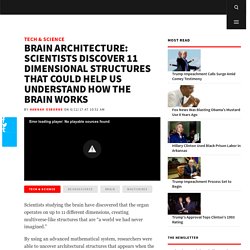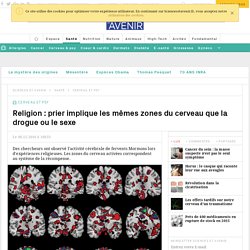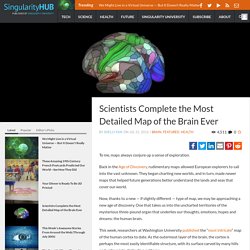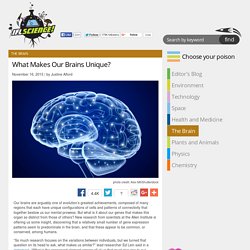

Sciencemag. Alien limb syndrome isn’t as extraterrestrial as it sounds—but it’s still pretty freaky.

Patients complain that one of their hands has gone “rogue,” reaching for things without their knowledge. “They sit on their hand trying to get it not to move,” says Ryan Darby, a neurologist and neuroscientist at Vanderbilt University in Nashville. “They’re not crazy. They know there’s not something controlling their arm, that it’s not possessed. Comment votre cerveau distingue les bonnes des mauvaises odeurs. L'odeur de votre collègue "que vous ne pouvez pas sentir" vous insupporte, celle de la lavande vous apaise et celle d'un steak vous met systématiquement l'eau à la bouche.

Is There a Multidimensional Mathematical World Hidden in the Brain’s Computation? Two thousand years ago, the ancient Greeks looked into the night sky and saw geometric shapes emerge among the stars: a hunter, a lion, a water vase.

In a way, they used these constellations to make sense of the random scattering of stars in the fabric of the universe. By translating astronomy into shapes, they found a way to seek order and meaning in a highly complex system. As it turns out, the Greeks were wrong: most stars in a constellation don’t have much to do with one another. Advancing Techniques Reveal the Brain’s Impressive Diversity. For years, neurons in the brain were assumed to all carry the same genome, with differences in cell type stemming from epigenetic, transcriptional, and posttranscriptional differences in how that genome was expressed.

But in the past decade, researchers have recognized an incredible amount of genomic diversity, in addition to other types of cellular variation that can affect function. Indeed, the human brain contains approximately 100 billion neurons, and we now know that there may be almost as many unique cell types.
Our interest in this incredible diversity emerged from experiments that we initially labeled as failures. Brain Architecture: Scientists Discover 11 Dimensional Structures That Could Help Us Understand How the Brain Works. Scientists studying the brain have discovered that the organ operates on up to 11 different dimensions, creating multiverse-like structures that are “a world we had never imagined.”

By using an advanced mathematical system, researchers were able to uncover architectural structures that appears when the brain has to process information, before they disintegrate into nothing. Their findings, published in the journal Frontiers in Computational Neuroscience, reveals the hugely complicated processes involved in the creation of neural structures, potentially helping explain why the brain is so difficult to understand and tying together its structure with its function. Subscribe to Newsweek from $1 per week Related: Scientists discover what falling in love looks like by studying the brains of prairie voles "Algebraic topology is like a telescope and microscope at the same time.
On a compris l'origine de l'effet relaxant de la méditation sur le cerveau - Science-et-vie.com. Si la méditation relaxe, c'est parce qu'elle synchronise l'activité électrique d'une partie du cerveau.

Des chercheurs américains ont validé cette hypothèse sur des souris, en stimulant leur neurones avec de la lumière. On sait que chez l'homme, après un mois de méditation, une zone du cerveau appelée cortex cingulaire antérieur (ACC) est anormalement activée. L'image de la semaine: «Les neurones géants dans le cerveau, siège de notre conscience ?» L'image de la semaine: «Les neurones géants dans le cerveau, siège de notre conscience ?»

Des chercheurs viennent de déceler chez la souris des neurones géants à l’intérieur du claustrum, une mystérieuse structure cérébrale qui pourrait jouer un rôle important dans la conscience. Les explications de cette découverte inédite avec ce nouvel article du blog «Aux frontières du cerveau». L’origine et le support de la conscience sont parmi les questions les plus débattues dans le domaine de la psychologie et des neurosciences. Religion : prier implique les mêmes zones du cerveau que la drogue ou le sexe.
CERVEAU.

Comme la drogue, le sexe, la musique, la nourriture ou encore les jeux d'argent, les sentiments religieux activent les zones cérébrales impliquées dans le circuit de la récompense. C'est ce qui ressort d'une étude menée par l'université de l'Utah aux Etats-Unis et publiée dans la revue Social Neuroscience. Dans le cerveau, le circuit de la récompense - ou système de renforcement - est formé de structures reliées les unes aux autres. Lorsqu'il s'active, le sujet ressent de la satisfaction.
Scientists Complete the Most Detailed Map of the Brain Ever. To me, maps always conjure up a sense of exploration.

Back in the Age of Discovery, rudimentary maps allowed European explorers to sail into the vast unknown. They began charting new worlds, and in turn, made newer maps that helped future generations better understand the lands and seas that cover our world. Now, thanks to a new — if slightly different — type of map, we may be approaching a new age of discovery. One that takes us into the uncharted territories of the mysterious three-pound organ that underlies our thoughts, emotions, hopes and dreams: the human brain. This week, researchers at Washington University published the “most intricate” map of the human cortex to date.
To many, the cortex represents the seat of human intelligence: not only does it process information from our various senses, it also drives higher cognitive functions, such as planning, strategy and self-control. Can Plants Think? What Makes Our Brains Unique? Our brains are arguably one of evolution’s greatest achievements, composed of many regions that each have unique configurations of cells and patterns of connectivity that together bestow us our mental prowess.

But what is it about our genes that makes this organ so distinct from those of others? New research from scientists at the Allen Institute is offering us some insight, discovering that a relatively small number of gene expression patterns seem to predominate in the brain, and that these appear to be common, or conserved, among humans. “So much research focuses on the variations between individuals, but we turned that question on its head to ask, what makes us similar?” Scientists Use Tiny Mouse Brain Sample to Map Neuron SynapsesVideo. Researchers Reveal Nanoscale Images Of The Brain. Researchers have revealed some of the highest-resolution images of the brain ever created. Looking at the structures of the brain on a previously unachievable scale, the scientists have been able to image not just the individual neurons and blood vessels in a mouse brain, but, astonishingly, single junctions between cells and even the chemical-loaded vesicles within them.
The human brain is the most complex object in the known universe, and being made up of an estimated 86 billion neurons, consequently very little is actually known about its fine structure and function. Previous attempts at making fine scale images of the brain have come across a few problems. Basically, researchers could either make a low-resolution 3D image, or a high-resolution 2D one. Scientists Grow Miniature Brains From Skin Cells Of Autistic Patients. Due to their complexity, and the fact that brain development is difficult to emulate in the lab, scientists struggle to understand neurological disorders such as autism and schizophrenia. In a bid to overcome these hurdles, a group of researchers has been growing mini brains in petri dishes from the skin cells of autistic patients.
The micro-brains might not be big, but what they have shown the researchers may have big implications for the future of autism research. Generally, studies into autism examine patient genomes and search for any mutations that might be responsible for the disorder. Then, once a possible mutation is identified, its effects on development are tested on animal models or cells. The research team, however, decided to take the opposite approach: grow a brain and see which genes express themselves unusually. Scientists have launched the first open-access database for neurons. The human brain is a busy, bustling place, with around 100 billion neurons processing and transmitting information via electrical and chemical signals.
And to make things even more complex, each of these neurons has about 10,000 different connections to neighbouring brain cells. Over several decades, scientists have learned a lot about how different neurons function and interact with each other. But in doing so, they’ve amassed huge amounts of data, spread across tens of thousands of scientific papers. Making matters worse is the fact that methods of collecting and reporting this data are often inconsistent. Study Of More Than 3,500 Human Brains Reveals The Cause Of Alzheimer's Disease. After examining more than 3,500 donated brains, scientists have gathered evidence to suggest that a rogue protein, tau, which has long been suspected to play a role in the development of Alzheimer’s, is the major driver of cognitive decline in this disease. These new findings downplay the role of amyloid, another dysfunctional protein that builds up as the condition progresses and has been the focus of much Alzheimer’s research.
Although this discovery does not mean that the debate over which protein is the biggest contributor to disease progression is over, it does have implications for future research, and the scientists suggest that therapeutics should now focus on tackling tau, rather than amyloid. Brain-To-Brain Interfaces: The Science Of Telepathy. Have you ever wondered what it would be like to walk a mile (or 1.6 kilometres) in somebody else’s shoes? Or have you ever tried to send a telepathic message to a partner in transit to “pick up milk on your way home”? Recent advances in brain-computer interfaces are turning the science fantasy of transmitting thoughts directly from one brain to another into reality. Studies published in the last two years have reported direct transmission of brain activity between two animals, between two humans and even between a human and a rat.
These “brain-to-brain interfaces” (BBIs) allow for direct transmission of brain activity in real time by coupling the brains of two individuals. So what is the science behind this? Reading The Brainwaves. ?articles. New Brain Map Reveals Unknown Cell Types. Researchers have produced a detailed map of brain cells and the genes that are active within them. Their work, published in Science this week, even revealed a handful of previously unknown types of cells. In mammals, the cerebral cortex plays a role in cognitive functions like memory and social behaviors, and these all rely on a variety of cell types: from neurons and their protective glial cells to blood vessel cells. There are about 100 million cells in a mouse brain, and 65 billion cells in a human brain.
A Swedish team led by Jens Hjerling-Leffler and Sten Linnarsson of Karolinska Institutet wanted to create a more detailed brain map that could help us better understand how brain cells respond to diseases and injuries. Using a technique called single cell sequencing, they were able to classify the cells in the mouse somatosensory cortex and hippocampal CA1 region. Le cerveau à tous les niveaux. Le cerveau à tous les niveaux. Comment fonctionne la mémoire.
Je me répète: la science prend du temps, je publie quand je peux, le mieux est de me suivre sur Twitter, Facebook ou Google Plus. Un grand merci à Stefania De Vito, chercheuse en sciences cognitives à l’ICM, Hôpital de la Salpêtrière. Tom Wujec: 3 ways the brain creates meaning. Lucid Dreamers Show Better Self-Reflecting Capabilities When Awake. The ability to control what happens in one's dreams is an endearing prospect, so much so that there are pages of information online which supposedly help individuals achieve this curious state, which is known as lucid dreaming. Despite being a well-recognized phenomenon, we still know very little about it, nor why some people seem to experience it more frequently than others. Now, a new study by scientists at the Max Planck Institute has offered some novel insight into the subject with the finding that a particular brain region known to be involved in self-reflection is larger in lucid dreamers.
According to the researchers, this could mean that lucid dreamers are better at self-reflecting during wakefulness. Viruses May Play Vital Role In Brain Function. Out of the 3 billion base pairs in the human genome, only about 2% actually codes for protein. Hidden in the vast sequences of non-coding DNA responsible for genetic regulation are retroviruses that we have picked up throughout our evolutionary history. Viruses are usually equated with disease, that is not always the case. David Anderson: Your brain is more than a bag of chemicals.
Seeing mathematics: Perceptual experience and brain activity in acquired synesthesia - Neurocase - Volume 19, Issue 6. Peter Doolittle: How your "working memory" makes sense of the world. Close Help with subtitles Desktop / laptop users: please make sure you have the most updated versions of your browser and Flash player, and that Flash is enabled when you visit TED.com. iOS users: to access subtitles, start playing the video, then tap the speech bubble icon that appears in the bottom row of video controls. Android users: although Android devices do not support subtitles, you can download the TED app from the Google Play store. Andres Lozano: Parkinson's, depression and the switch that might turn them off. Early Birds vs Night Owls. Rebecca Saxe: How we read each other's minds. What percentage of your brain do you use? - Richard E. Cytowic. Brain Training Can Teach Synesthesia-Like Perception. For 95.6% of the people reading this, every word in this article (excluding hyperlinks) will appear black.
The remaining 4.4% will have a different experience altogether. Perhaps the M's will appear orange, while the A's take on a violet hue. These individuals have a condition known as synesthesia, which is a tangling of sensory input. While interpreting letters or numbers as color is the most common manifestation of this phenomenon, certain people may believe that reading certain words “tastes” a certain way, while others “hear” music when eating certain foods. Jeff Hawkins: How brain science will change computing.
Playing Video Games Is Good For Your Brain – Here’s How. Whether playing video games has negative effects is something that has been debated for 30 years, in much the same way that rock and roll, television, and even the novel faced much the same criticisms in their time. Purported negative effects such as addiction, increased aggression, and various health consequences such as obesity and repetitive strain injuries tend to get far more media coverage than the positives. I know from my own research examining both sides that my papers on video game addiction receive far more publicity than my research into the social benefits of, for example, playing online role-playing games. Aging Brains Aren’t Necessarily Declining Brains. For years, conventional wisdom held that growing older tends to be bad news for brains.
Past behavioral data largely pointed to loss in cognitive – that is, thinking – abilities with age, including poorer memory and greater distractibility. Students Link Brains to Fire Video Game Cannon. Students Link Brains to Fire Video Game Cannon.
Neuronal Regeneration. Memory & Learning Process. Scientists Develop Brain Decoder That Can Read Your Inner Thoughts. It’s not quite telepathy, but a group of scientists have successfully eavesdropped on our inner thoughts for the first time. Ariel Garten: Know thyself, with a brain scanner. Transparent Graphene-Based Implants to Grant Clearer View of the Brain. How does my brain work? Jeff Iliff: One more reason to get a good night’s sleep. Could Telepathy Exist In Real Life? How does my brain work? What happens when you remove the hippocampus? - Sam Kean. Researchers Discover How Deadly Rabies Virus Hijacks And Manipulates Nerve Cells. Joshua Foer: Feats of memory anyone can do. Scientists Discover Strange New Brain Cell Shape. Your Brain Can Make Decisions During Sleep. 5 Ways Social Media Is Changing Your Brain. Experimental Rat ‘Brain’ Fighter Pilot May Yield Insights Into How the Brain Works.
Direct Brain-To-Brain Communication Used in Humans. Chattering brain cells hold the key to the language of the mind. Neuromodulation 2.0: New Developments in Brain Implants, Super Soldiers and the Treatment of Chronic Disease. Neurons In Your Skin Do Math. Scientists Successfully Reverse Emotions Associated With Memory.
Researchers Boost Memory Using Magnetic Stimulation. Are Your Bacteria Making You Fat? Is Your Red The Same As My Red? Scientists Create Functional 3D Brain Tissue. Crayfish Grow New Brain Cells From Blood Cells. IBM Reveals Incredible New Brain-Inspired Chip. Transplanted Neural Stem Cells Successfully Integrate Into The Brain. How to Virtually ‘Possess’ Another Person’s Body Using Oculus Rift and Kinect. Seven Myths About The Brain That Most People Believe. Meet The Amoeba That Eats Your Brain. (1) Religion is a mental disorder.
Brain Cell Transplantation Restores Learning And Memory In Mouse Models Of Alzheimer's. Bigger Is Better After All. DARPA Wants Brain Implants For Restoring Memories. RENNES20070412112616bmilletInitiation_aux_sciences_cognitivesPCEM1_23_02_2007.pdf. New approach to gene therapy for neurodegenerative diseases makes use of a virus as delivery agent. Brain Waves Synchronize for Faster Learning. Stunning Flythrough Views of Intact Brains. Is "Free Will" Just The Result Of Background Noise In The Brain? Scientists Induce Lucid Dreaming With Electrical Stimulation. Scientists Develop A Way To Visualise The Brain In Real-Time. New Information On Nerve Repair May Bring Hope To Spinal Injury Patients. Des souris avec des cellules cérébrales humaines sont plus intelligentes. Alzheimer: des chercheurs découvrent une protéine qui jouerait un rôle capital dans le développement de la maladie.
« Le ventre, notre deuxième cerveau » Researchers Make Huge Step Forward In Understanding How The Brain Processes Emotions. Maladie d’Alzheimer : la piste du poisson-zèbre. Religious Children Struggle To Separate Fact From Fiction.